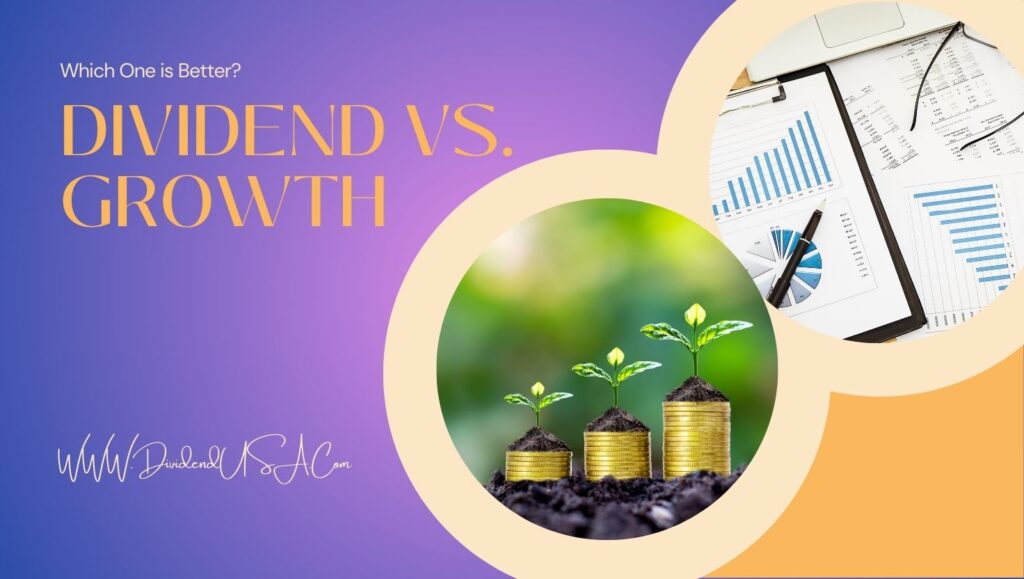Join WhatsApp Group
Join NowDividend stocks provide regular income (e.g., Coca-Cola, AT&T) but may grow slower, while growth stocks (e.g., Tesla, Amazon) offer higher appreciation potential but usually pay no dividends. Choose dividend stocks for passive income and stability; pick growth stocks for long-term capital gains.
Dividend vs Growth Stocks: Key Differences

| Factor | Dividend Stocks | Growth Stocks |
|---|---|---|
| Primary Goal | Income + moderate growth | Capital appreciation |
| Payouts | Regular dividends (quarterly/monthly) | Rarely pay dividends |
| Volatility | Lower (stable sectors like utilities) | Higher (tech, biotech) |
| Examples | Coca-Cola (KO), Johnson & Johnson (JNJ) | Tesla (TSLA), NVIDIA (NVDA) |
| Best For | Retirees, passive income seekers | Long-term investors, risk-tolerant |
What Are Dividend Stocks?
Dividend stocks are shares of companies that distribute a portion of their profits to shareholders regularly, typically quarterly. These stocks are often issued by mature, stable companies (e.g., Coca-Cola, Procter & Gamble, ITC, Vedanta) with predictable cash flows, allowing them to reward investors with consistent payouts. Dividend stocks are popular among income-focused investors, retirees, and those seeking lower volatility, as they provide passive income even during market downturns. Key metrics to evaluate them include dividend yield, payout ratio, and growth history (e.g., Dividend Aristocrats with 25+ years of increases).
Pros & Cons of Dividend Stocks
✅ Advantages
- Steady cash flow (e.g., $1,000/month from a $400K portfolio)
- Lower volatility – Defensive sectors (consumer staples, utilities)
- Dividend growth – Companies like KO raise payouts for decades
- Tax benefits – Qualified dividends taxed at 0-20%
❌ Disadvantages
- Slower price growth – Mature companies expand less aggressively
- Dividend cuts risk – If company profits decline (e.g., AT&T in 2022)
- Interest rate sensitivity – Bonds may lure income investors away
Who Should Invest in Dividend Stocks?
Best If You:
- Need monthly/quarterly income (e.g., retirees)
- Prefer lower volatility (stable sectors like healthcare)
- Want tax-advantaged payouts (vs. bond interest)
- Like predictable returns (Dividend Aristocrats)
Portfolio Example:
- 60% Dividend stocks (KO, JNJ, O)
- 30% Bonds
- 10% Cash
What Are Growth Stocks?
Growth stocks represent companies that reinvest earnings into expansion rather than paying dividends, aiming for higher future valuations. These stocks are common in fast-moving sectors like technology (e.g., NVIDIA, Tesla), where businesses prioritize scaling operations, R&D, and market dominance. Growth stocks tend to be more volatile but offer the potential for significant capital appreciation over time. Investors in these stocks typically rely on rising share prices rather than income, making them ideal for long-term portfolios with higher risk tolerance. Key assessment factors include revenue growth, profit margins, and industry trends.
Pros & Cons of Growth Stocks
✅ Advantages
- Higher upside potential – Amazon grew ~100,000% since IPO
- Reinvestment – Companies plough profits back into expansion
- Innovation exposure – AI, cloud computing, EVs (e.g., NVIDIA)
❌ Disadvantages
- No income – You must sell shares to realise gains
- Higher risk – Can crash 50% + in downturns (e.g., Meta in 2022)
- Valuation bubbles – Overhyped stocks may collapse (e.g., dot-com era)
Who Should Invest in Growth Stocks?
Best If You:
- Have 10+ years to invest
- Can tolerate 30-50% short-term swings
- Believe in disruptive tech (AI, renewables, biotech)
- Don’t need immediate income
Portfolio Example:
- 70% Growth stocks (TSLA, NVDA, AMD)
- 20% ETFs (VGT, QQQ)
- 10% Cash for dips
How to Combine Both Strategies?
The Hybrid Approach
- Core (50%): Dividend stalwarts (PEP, PG)
- Growth (30%): High-potential stocks (GOOG, MSFT)
- Flex (20%): ETFs (SCHD + VUG) or REITs
Benefits:
✔ Income from dividends
✔ Growth potential from tech/innovators
✔ Lower overall risk
FAQs
❓ Which performs better long-term?
Historically, growth stocks outperform, but dividends provide consistent returns in downturns.
❓ Can growth stocks become dividend stocks?
Yes (e.g., Apple, Microsoft started paying dividends after maturing).
❓ Are dividend stocks safer?
Generally yes, but avoid high-yield traps (unsustainable payouts).
❓ How to find the best growth stocks?
Look for high revenue growth (20%+), strong moats, and profitable sectors (AI, cloud).
Final Verdict: Which Should YOU Choose?
- Choose Dividend Stocks If: You want income + stability.
- Choose Growth Stocks If: You seek aggressive wealth building.
- Best of Both Worlds? A 60/40 dividend/growth split balances safety and upside.


